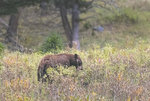Cloudy, 27° F
With the help of an organization of hunters, Wyoming Game and Fish officials are attempting to do something they’ve never done before: count black bears.
While department biologists know the …
This item is available in full to subscribers.
The Powell Tribune has expanded its online content. To continue reading, you will need to either log in to your subscriber account, or purchase a subscription.
If you are a current print subscriber, you can set up a free web account by clicking here.
If you already have a web account, but need to reset it, you can do so by clicking here.
If you would like to purchase a subscription click here.
Please log in to continue |
|


With the help of an organization of hunters, Wyoming Game and Fish officials are attempting to do something they’ve never done before: count black bears.
While department biologists know the species has steadily increased in number, they can’t say how many black bears actually reside in the state. Previously, population trends have been calculated primarily on harvest data. That’s about to change.
A new study, funded in part by the Western Bear Foundation, should soon result in more accurate local population estimates, leading to a better understanding on how to best approach conservation of the species, said Dan Thompson, the department’s large carnivore supervisor.
“The study is going to help our understanding of black bears. But it’s hard to just go out and count them,” Thompson said.
Biologists for the department are systematically heading into black bear habitat across the state, including the Big Horn Basin. They’re collaring individuals to watch their movement, constructing hair snare traps in dozens of grids and analyzing bears’ DNA — all to increase knowledge of the species and their density. The project will ultimately take years to complete, but the Game and Fish is well on its way.
Large carnivore biologist Ryan Kindermann is heading up much of the population estimate research. He’s already worked on studies in the Greys River and Sierra Madre ranges and this year he led the effort to trap 19 black bears in the Bighorn Mountains, attaching collars on 14 of the animals. It was the most black bears successfully trapped in the three areas so far. The collars will stay on the bears for two years before automatically dropping off and being collected by biologists. Collars cost about $3,000 each, but can be reused, Kindermann said.
It’s a story of two bears in the state. While grizzly bears have been one of the most studied wildlife species on the planet — becoming a political football and capturing the attention of many wildlife enthusiasts — interest, scientific knowledge and funds available for black bear conservation studies are relatively limited. The department has studied the species, Thompson said. Yet, their density remains a mystery.
There were no protestors in attendance as Game and Fish large carnivore experts held a public meeting about their plans in Cody last week. There were no gasps as team members revealed statistics showing hunter’s harvests of black bears have gone up more than 300 percent in the past two decades — from about 150 bears in 1999 to more than 450 this year. Only a handful of people took time to show up at the Park County Library to hear a special report on the species. All were hunters.
In comparison, hundreds showed up at Game and Fish scoping meetings when proposing grizzly hunts in 2017. Scheduled hunts were eventually canceled after grizzlies were relisted for protection under the Endangered Species Act later that year.
“People simply view grizzly bears differently than black bears,” Thompson said.
The Game and Fish Department has spent tens of millions of dollars studying and managing grizzlies in the more than 40 years since they were listed. The federal government currently only kicks in $100,000 a year for management of the species. The bulk of the money comes from hunting fees for licenses and permits. So it’s not uncommon for hunters to foot the bill for management of wildlife species.
It was the lack of funding for black bears that inspired the Western Bear Foundation to invest in research, said Joe Kondelis, president of the nonprofit, all-volunteer organization.
“No one is paying attention to black bears. That’s why we founded this organization,” he said. “We love grizzly bears. We do a lot for them. But black bears are an iconic species in this country and they deserve attention, too.”
Kondelis has joined Game and Fish teams several times to help set traps and assist in research. The organization’s focus is to ensure the future of bears and bear hunting in the Western United States. They’re now funding population studies of black bears in Wyoming, Idaho and Montana — areas where black bear co-exist with larger, more aggressive grizzly bears.
Despite harvests of black bears consistently breaking records, 2019 was a banner year for black bear conflicts in parts of the state as populations continue to trend slightly upward, Thompson said. “We saw a high level of damage removals this year.”
In northwestern Wyoming, slight increases in harvest limits are being proposed in the northern Bighorns. Further, the Game and Fish wants to change the boundaries of a portion of northern Bighorn Mountain hunt areas into the Big Horn Basin’s Hunt Area 32. The change is being made to assist management efforts, putting hunters on black bears in conflict.
The predator has proven they can cause damage and put both humans and livestock in danger — although to a lesser extent than grizzlies. Fourteen black bears have been lethally removed this year in the Bighorn Mountains, primarily for exhibiting food conditioned behavior.